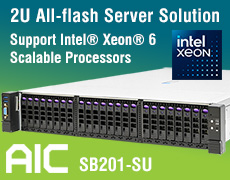History (1992): After 2.5-Inch, 1.8-Inch Form Factor De Facto Standard for HDD
Adopted up to now by Integral, MiniStor, Aura, NEC, Western Digital, and especially IBM
By Jean Jacques Maleval | June 2, 2020 at 2:18 pmSome try to develop 1.3-inch disk drives (Hewlett-Packard for instance) or 1.5-inch ones like Ecol 2. But industry has just decided that the de facto standard will be 1.8-inch after the 2.5-inch form factor. Integral, MiniStor, Aura, NEC, Western Digital and especially IBM adopted it. Conner, Quantum and Seagate should follow the movement which seems to be irreversible.
The first 1.8-inch microdisk drives, wonders of miniaturization, are just coming out of factory. With a surface smaller than a credit card, these drives are hardly more than 1cm wide and weigh less than 100 grams. They can store 20 or 40MB. But 60 and 80MB are already mentioned.
The first 2.5-inch Winchester drives, 3x smaller than 3.5-inch ones, were launched at the end of 1989. Hardly 2 years after, at the end of 91, the first 1.8-inch drives were announced, once more 3x smaller.
Will we reach a 1-inch or a 1.3-inch format in two years?
Integral Peripherals (Boulder, CO) is the first one to have started a small production of 1.8-inch HDDs. But most manufacturers should unveil their own models before the end of the year. These microdisks are 7 to 8cm long, 5cm wide and 1.3 to 1.5cm high.
In this tiny volume, everything can be found: the HDA with 1 or 2 magnetic platters, the arms and the heads, the motor and even a controller with an AT or PCMCIA interface.
These drives are aimed for the smallest microcomputers, notebooks, palmtops and other penbooks, but could also be used to store data on copy machines, faxes, phones, systems for car navigation, etc.
And especially since their power consumption is low, a maximum of 5W. Their other specs are just as good as any excellent HDD: a 20ms access time and even less, a rotational speed that can reach up to 5,400rpm. Additionally, they are reliable, with a 100,000-hour MTBF and a 100 to 300G operating shock.
Today they cost around $300 in OEM quantities, which is rather expensive, but it’s just a start. Let’s not forget that two years ago, the first 2.5-inch drive with 20MB cost $650 and that today it sells for $100 less with 120MB.
IBM and 3 other US start-up companies, waiting for others
At least 4 companies, all US, already showed 1.8-inch models officially.
The first one is not the smallest one, IBM, with a 40MB drive that Big Blue qualified as a ‘technology announcement’, which means in terms of the company that the final product will probably be available 6 to 12 months after. It will be produced in its Fujisawa plant in Japan.
The three other pioneers are start-up companies in California and Colorado, just like it ought to be in storage industry. And as usual, or almost, the method to start is the same. Take a clever technician and a good businessman, both disappointed by some drive manufacturer they left, have them built a prototype, and manufacturing and marketing plans. Afterwards, let them go around a few Californian venture capitals and then, with more insistence, around some large Japanese companies that will add in a good financial support, in exchange of marketing and manufacturing agreements.
First MiniStor and Integral
It was in September 1991 that MiniStor Peripherals (San Jose, CA) and Integral Peripherals each unveiled their first units with a production that began a few weeks ago.
MiniStor has raised some $12.4 million in 2 rounds of outside financing since its founding 2 years ago. Seiko Epson and Samsung took an equity stake in the start-up company in February. TechniStar Corp. (Longmont, CO) is designing for MiniStor a highly automated production line to complement a more conventional one in Singapore. MiniStor has also a technology deal with Zilog (Campbell, CA) for a custom chip based on Zilog’s 78 controller for its new drives.
As of August 1991, Integral Peripherals, founded in September 1990 by several executives from PrairieTek, was the first one to ship evaluation units of 20MB drives with a volume production in December. Just for 1991, Integral recuperated $22.2 million from various investors, notably Sumimoto and an industrial partner that could be Fuji Electric, to open a plant in Singapore.
Last March, Integral began to ship its Stingray 1842, a 40MB unit with an IDE interface produced at the company’s pilot manufacturing facility in Boulder, with volume production scheduled for April.
Additionally, the manufacturer began shipping this month its Stingray 1842P with volume production scheduled in June. It’s the same drive but with a PCMCIA style connector. This means that the printed circuit board will have a 68-pin connector. The drive will physically fit a PCMCIA style slot, but the interface will be IDE.
“This feature provides the system designer with ease of manufacturing,” said Integral, “because of the elimination of mounting holes; a standard connector that will allow interchangeability between Integral’s drive and memory cards, modems and other peripherals; and a removability option.”
Aura and NEC
The last actor is Aura Associates (Saratoga, CA) that launched last May its Golden Series that includes the AU 426, a formatted 42.6MB drive and the AU 853, with 85.6MB on 2 platters. First customer shipments of the AU 426 will be made in 2092 with volume production scheduled for 3Q92, 3 months later for the AU 853. Prices for one unit are $300 for the first model, $360 for the second one, OEM prices for a 10,000 quantity per year.
“The new products are the result of an intensive 18-month, secretive, well-funded development program which has brought together some of the world’s most foremost design engineers in head disks, drive mechanics, servo and microcode to integrate advances in their respective fields into single product,” said Aura. “The drive’s performance doesn’t rely on any untested innovations (with inherent poor initial yields) but utilizes tried and tested components to produce high quality ruggedized products capable of being manufactured on automated production lines.“
The AU 426, single disk, spins up at 5,400rpm in less than one second, leading to a 5.5ms latency and data transfer rates from its 32KB buffer memory of 4.5MB/s and 3.0MB/s maximum from media. Powered from a single 5V supply, it uses 3.2W during 100ms to start, 2.2W in R/W seek, 0.15W in sleeping mode. The drive weighs 75 grams and withstands non operating shocks of 100G and operating shock of 10G. The size is 50.8mm (2 inches)x70.0mm (3 inches)x12.7mm (0.5 inches). The MTBF is rating at 100,000 hours. The average seek time is 19ms. The interface is a PC/AT type but the PCMCIA connection is planned for next year.
The AU 853, twin disk 85.3MB 1.8-inch drive has all the features of the AU 426 but is 15 grams heavier and 2.3mm (0.09 inch) taller. Aura is also working on a drive with 60MB in one disk on a r movable cartridge that holds the disk and the R/W heads like SyOuest Technology had originated but with no success.
Aura Associates, Inc. was founded in 1986 by Dr. John Scott, chairman and CEO, and Wendell Bale, president. Its activity began with consulting on HDDs and on disks, then in designing these 1.8-inch HDDs since 1990.
At Las Vegas’ Comdex/Fall in 1988, Aura showed a drive with 4 independent actuators in the 4 corners of a drive named Associates Fast 1 with a 2ms access time. This concept went no further but was partly taken over by Conner Peripherals with its Chinook and its two independent actuators.
According to its executives, Aura now employs in Saratoga 45 people where 40 are full-time engineers just working on this project.
According to reliable sources, Tom Mitchell, the former CEO of Commodore, and one of Seagate’s founders and previous president, could join Aura before the end of the year, and just as secretly, that two other HDD manufacturers, Areal Technology and Kalok, could also take part in this business.
An agreement is being completed with NEC who confirms and was even showing one of these small marvels on its booth at last CeBIT in Hanover, Germany. The Japanese company will do part of te manufacturing, probably the 42.6MB drive shown at the event. The rest of the production could be done as of the end of this year in Europe by Orca Electronics GmbH in a plant in Meiningen, a 2-hour drive from Frankfurt, in Germany, a half million square foot facility, where the (ex) East German Robotron firm secretly manufactured thin-film media and 5.25-inch drives by brazenly copying US technologies.
Orca Electronics has contacts with Orca Technology Corp. (San Jose, CA) founded in 1990 to take over part of the technology on HDDs developed by Priam. The company has manufacturing agreements with Magtron and Zentek, both in Taiwan.
Behind this 1.8-inch disk manufacturing project in Europe, there is Bisser Dimitrov, VP, international operations of Orca Technology, who has over 20 years of technical and management experience in Bulgarian high-technologies and ministry, serving as IBM’s Bulgarian country manager. As an advisor to former deputy prime minister Doynov, he was VP and chairman of several multi-billion dollar companies which included Personal Computer Instrumentation & Automation and Peripheral Data Systems in Bulgaria. Before joining Orca, he was executive VP marketing for Valley Machine and Tool USA.
More ongoing projects
Many other well-known manufacturers are working on the 1.8-inch form factor. Tiny is the code name of a project ongoing at Conner Peripherals (San Jose, CA) for its 30 and 60MB drives that could be announced at next Comdex/Fall.
At last CeBIT, Alan Shugart, CEO of Seagate Technology (Scotts Valley, CA), took out of his pocket a 60MB 1.8-inch disk in a little room behind his booth.
Fujitsu is also mentioned.
Western Digital (Irvine, CA) is handing out prototypes of a PB-140 model, the first one of a family under the Bullet code name. It’s a 1.8-inch PCMCIA drive with a a formatted 42.7MB capacity on a magnetic platter with 1,008 tracks and an RLL 1.7 recording mode, a 32KB buffer, with a 6.7ms average rotational latency, a 19ms access time in read mode and 24ms in writing mode, a track-to-track seek time of 5ms. Operating shock should be 10G and the non operating shock 100G. This PB-140 should be in production in December 1992 and followed by a model with 85.5MB on 2 platters.
Flash cards or microdisks?
In new small drives, competition could come from flash cards with their semiconductor non volatile memory.
SunDisk (Santa Clara, CA) is already shipping cards with capacities reaching 40MB, but at outrageous prices. They are thinner, use less power and can read data much quicker. But they are slow for writing, and especially far more expensive, from 1 to over 10x more per megabyte.
Important announcements from AMD and Intel concerning a new flash card to replace HDDs are expected this month. And why couldn’t minidisks and flash cards coexist on the same microcomputers? These coming devices could have several slots with 68-pin PCMCIA connectors, a standard for flash cards. This way there would be a slot for a high capacity disk necessary in today’s computer applications, a second one for a smaller capacity flash card that could, for instance, replace a 3.5-inch floppy disk drive, a third one for a modem, a fourth one for a fax card, etc., all of them removable.
HDD drive form factors
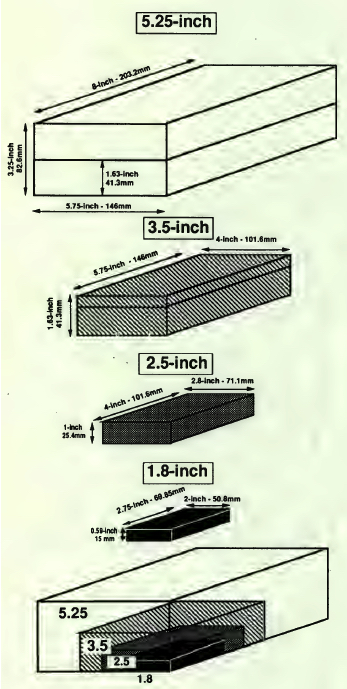
1.8-inch HDDs
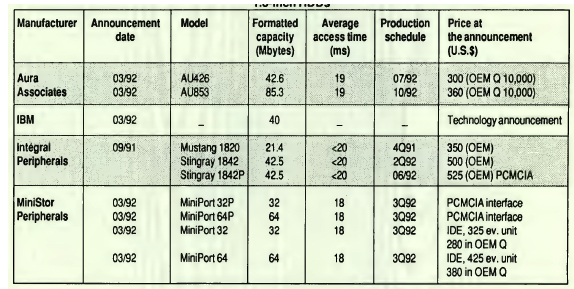
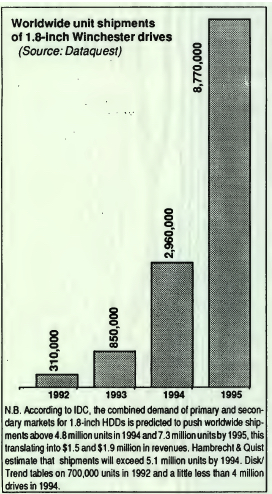
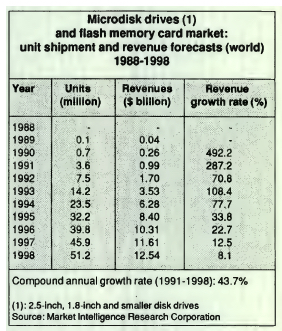
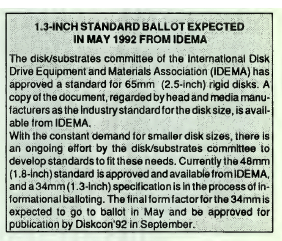
This article is an abstract of news published on the former paper version of Computer Data Storage Newsletter on issue ≠51, published on April 1992.














 Subscribe to our free daily newsletter
Subscribe to our free daily newsletter

